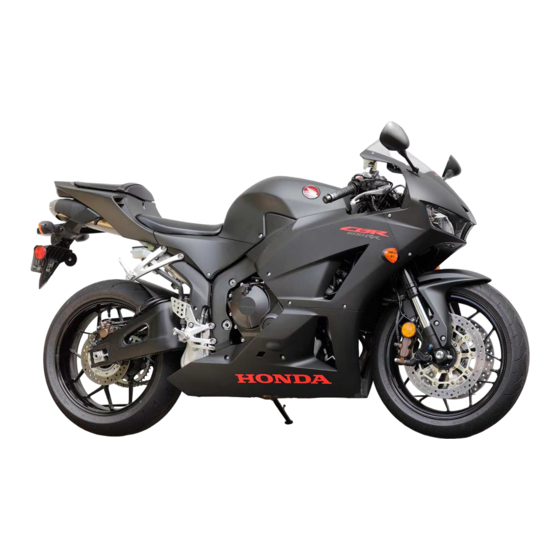
Summarization of Contents
Vehicle Safety
Safety Guidelines
Guidelines to enhance rider safety, including helmet use, pre-ride checks, and riding practices.
Safety Labels
Information on vehicle safety and hazard labels, emphasizing their importance and proper handling.
Safety Precautions
Precautions for safe riding, covering protective apparel like helmets, gloves, and boots.
Riding Precautions
Precautions for riding, including break-in period, brake usage, and handling various road conditions.
Accessories & Modifications
Advice against adding non-approved accessories or making modifications that can compromise safety.
Loading
Guidelines for proper vehicle loading to maintain handling, braking, and stability, and avoid overloading.
Operation Guide
Parts Location
Diagrams identifying the location of various parts and components on the vehicle.
Instruments
Explanation of the instrument panel features, including the tachometer, speedometer, and indicators.
Odometer & Tripmeter
Information on the odometer and tripmeters, including how to read and reset them.
Indicators
Description of various indicator lights on the instrument panel and their meanings.
Switches
Identification and function of various switches on the motorcycle handlebars.
Starting the Engine
Step-by-step procedure for starting the engine, including troubleshooting for non-starting issues.
Shifting Gears
Explanation of the transmission's shift pattern and recommended shift points for smooth gear changes.
Refueling
Instructions for refueling the vehicle, including fuel type, octane, and tank capacity.
Storage Equipment
Information on storage features like helmet holders, tool kits, and document bags located under the seat.
Maintenance
Importance of Maintenance
Explains why regular maintenance is crucial for safety, performance, and vehicle longevity.
Maintenance Schedule
Details the recommended maintenance intervals for various vehicle components and systems.
Maintenance Record
A log to record completed maintenance tasks, including distance, date, and performed by.
Maintenance Fundamentals
Basic principles and safety precautions to follow when performing vehicle maintenance.
Removing & Installing Body Components
Procedures for safely removing and installing various body parts like seats and cowls.
Engine Oil
Instructions on checking, adding, and changing engine oil and filter for optimal engine health.
Coolant
Procedures for checking and adding coolant to the reserve tank for engine temperature regulation.
Brakes
Guidance on checking brake fluid, inspecting brake pads, and adjusting brake light switches.
Side Stand
Instructions for checking the operation and safety features of the vehicle's side stand.
Drive Chain
Procedures for inspecting drive chain slack, wear, and lubrication, and adjusting it properly.
Clutch
Guidance on checking and adjusting clutch lever freeplay for smooth engagement.
Throttle
Instructions for checking and adjusting throttle freeplay to ensure smooth operation.
Other Adjustments
Details on performing various adjustments, including suspension and lever settings.
Adjusting the Front Suspension
How to adjust front suspension spring preload, rebound damping, and compression damping.
Adjusting the Rear Suspension
Instructions for adjusting the rear suspension's spring preload and damping settings.
Troubleshooting
Engine Will Not Start
Steps to diagnose and resolve issues when the engine fails to start or the starter motor operates.
Overheating
Guidance for addressing engine overheating, including checking the coolant temperature indicator and fan.
Warning Indicators On or Flashing
Explanation of warning lights like low oil pressure and PGM-FI, and actions to take when they activate.
Other Warning Indications
Information on other potential warning indications, such as fuel gauge failures.
Tire Puncture
Procedures for emergency tire repair and removing/installing wheels for puncture service.
Electrical Trouble
Troubleshooting common electrical issues such as battery problems, burnt-out bulbs, and blown fuses.
Information
Keys
Details about the ignition key, key number, and procedures for making duplicates or replacements.
Instruments, Controls, & Other Features
Overview of various controls, features, and systems like ignition, engine stop switch, and odometer.
Caring for Your Vehicle
Recommendations for cleaning, polishing, and protecting the vehicle's exterior and components.
Storing Your Vehicle
Guidelines for storing the vehicle properly for extended periods to maintain its condition.
Transporting Your Vehicle
Proper methods and precautions for transporting the vehicle, advising against towing with wheels on the ground.
You & the Environment
Information on responsible vehicle ownership, including choosing sensible cleaners and recycling wastes.
Vehicle Identification Number
Locating and recording the VIN and engine serial number for registration and parts ordering.
Emission Control Systems
Explanation of the vehicle's emission control systems and related requirements for exhaust and noise.
Catalytic Converter
Information on the catalytic converter's function, importance, and guidelines for its protection.
Oxygenated Fuels
Advice on using oxygenated fuels, including ethanol and methanol blends, and potential effects.
Authorized Manuals
List of available manuals, including service and owner's manuals, and how to order them.
Warranty Coverage and Service
Details on vehicle warranties, coverage limitations, and service recommendations.
Honda Contacts
Contact information for Honda customer service and dealer support for inquiries and feedback.
Reporting Safety Defects
Information on how to report potential safety defects to NHTSA and American Honda Motor Co., Inc.
Specifications
Main Components
Technical specifications for the vehicle's main components, including dimensions and weight.
Service Data
Key service data, including tire sizes, pressures, spark plugs, engine oil, and chain specifications.
Bulbs
Specifications for all vehicle bulbs, including wattage and type for headlights, signals, and lights.
Fuses
Specifications for main and other fuses, including amperage ratings for different models.
Torque Specifications
Torque values for critical fasteners and components, ensuring proper tightening during maintenance.











Need help?
Do you have a question about the CBR600RA 2020 and is the answer not in the manual?
Questions and answers